Orchard Establishment and Production
There are several important aspects of establishing a stone fruit orchard, which includes:
- Site Selection
- Chilling Units
- Planting Process
- Planting on Raised Beds
- Orchard Design
Site Selection
When choosing where to plant a stone fruit orchard, it is very important that the proper variety is matched to your site. Florida has a very diverse climate from the northern part of the state where freeze events can occur to Southern Florida, where freeze events are rare. The University of Florida breeding program has developed several varieties for North and Central Florida, with a renewed emphasis on breeding varieties for Central and Southern Florida.
Planting an orchard on the proper site and variety will allow growers to maximize their establishment efficiency with the minimum amount of replanted trees. Historical and current weather data for a particular orchard site can be found using the Florida Automated Weather Network (FAWN).
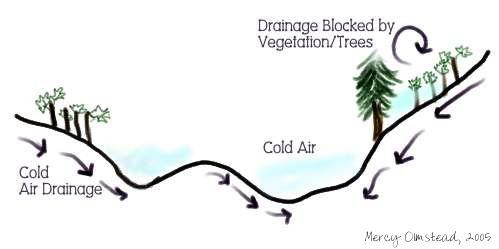
Cold air drainage can be achieved with even a slight slope, provided there are no physical obstructions such as buildings, windbreaks, or other forested areas (see above). Cold air drainage is particularly important when radiation freeze events occur. Radiation freezes occur on calm, clear nights when warm air rises and cold air settles in low areas. In these cases, the addition of wind machines can help, as well as constant irrigation during freezing temperatures.
Advective freezes can occur on cloudy or clean nights and are often characterized by windy conditions (>10 mph). In this case, strong northerly winds usher in cold air following the passage of a cold front. The windy conditions keep the air uniformly mixed and there are little differences cold or warm air above the orchard.
The use of irrigation can be used in both types of freezes to combat damage to flowers and fruit on the tree; however careful monitoring to ensure that a layer of ice continually forms is necessary. If the irrigation stops for any reason (e. g., blocked sprinkler, breaks in irrigation lines), damage can be more severe than if irrigation was not applied at all.
Proper water drainage in the soil is necessary in order to succeed in producing premium stone fruit varieties. Peaches and nectarines, in particular, do not tolerate hypoxia very well, and will quickly collapse and die if left in standing water for a prolonged period. This can especially be a concern as hurricane events occur in the summer and fall period in Florida.
Ideal Site
- Good cold air drainage which can be achieved with a slight slope and no physical obstructions
- Good water drainage in the top 4 to 6 feet (prolonged wet soil conditions, aka "wet feet")
- Few frost events if any, that require protection
- Proper accumulation of chilling hours
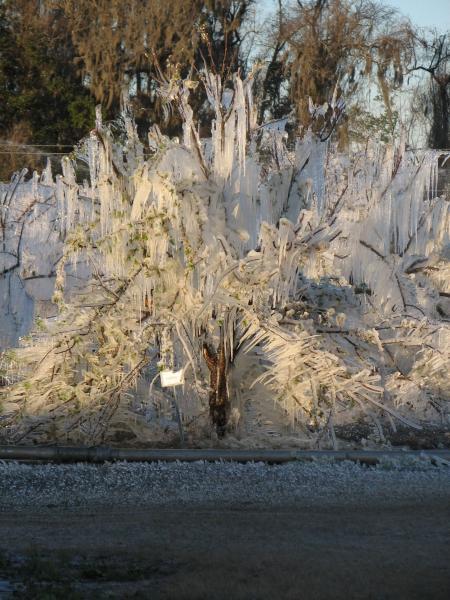
Photo by B. Hochmuth.
Chilling Units
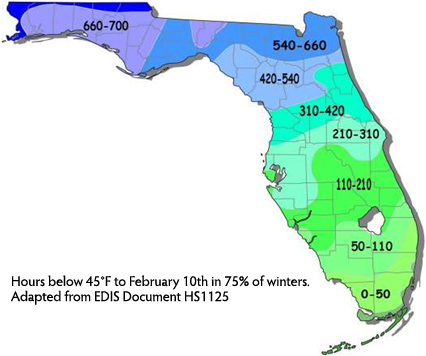
Chilling units or accumulation of chilling hours are very important for flowers and leaf buds to develop each year, and each variety may require a different number of accumulated units. Each chilling unit is equal to 1 hour in a specific temperature range. Chilling units (hours) are accumulated for each hour that is below 45°F and above 32°F. Chill units below 32°F are not effective since at this temperature the tissue (and its cellular contents) can be frozen. Each stone fruit variety that has been developed by the University of Florida breeding program lists the number of chilling hours required. Without sufficient chilling units, trees can exhibit delayed defoliation, reduced fruit set, and reduced fruit quality. For a comprehensive explanation of chilling accumulation and its importance, click here.
The FAWN network offers a biweekly accumulation of chill hours for tracking during the dormant season.
Planting Process
Stone fruit trees have traditionally been planted as bare-root grafted trees in the dormant season; however potted liners or whips (small trees with or without branching) that have been budded in June can also be planted in the fall and spring. Bare-rooted trees planted in the dormant season should be planted early enough to encourage as much root growth as possible before spring growth begins. Summer-planted trees should be managed with care, with adequate irrigation and fertilization to establish the root and shoot systems in the young tree.
Trees can be planted into the soil using a variety of agricultural planting implements, including tree augers and plows. When using tree planters or augers, be sure to break up the sides of the planting hole if the soil type is conducive to "glazing". Glazing occurs when sufficient clay and organic matter is present in wet soil and then is dug with a tree spade or auger. Soil glazing can slow root growth and water penetration into the surrounding soil profile.
Planting potted peach trees in research orchard, Hastings, FL. Notice herbicide strips to reduce weed competition with young trees for water and nutrients. Photos below by M. Olmstead.
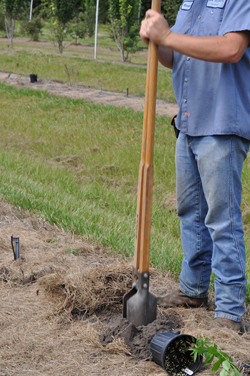
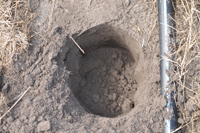
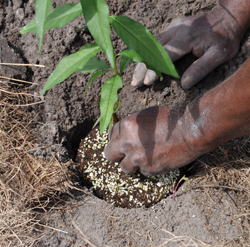
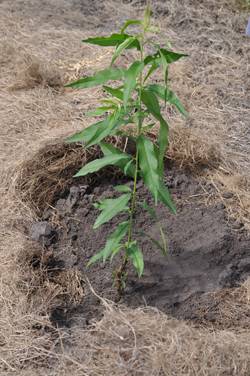
Planting on Raised Beds
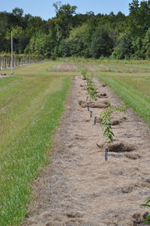
Orchard sites with poorly drained soils (especially "Flatwood" soils) may need to construct large raised beds in which the trees grow (see right). The dikes help to regulate the flow of water and help to facilitate drainage, and water is carried away into ditches which slope to one end of the field.
In potential sites that are level, heavy equipment can be rented or contracted to create a slight slope to increase water drainage and prevent water logging. In raised bed systems, it is essential to have a permanent sod cover on the sides of the beds and in the dikes to prevent soil erosion from the sides of the beds. The permanent sod cover is then maintained with occasional mowing or chemical "mowing" with herbicides.
The height of the beds can range from 24" to 36" depending upon the height of the water table and drainage ability of the soil. The drainage potential and other characteristics of a particular soil type can be verified using the Web Soil Survey from the USDA Natural Resource Conservation Service.
Orchard Design
A traditional planting system for peaches and nectarines in Florida has been using 20 feet between rows and 20 feet between trees. However, higher density systems are being explored with smaller tree sizes maintained through pruning and fruit thinning activities throughout the year (Table 1). There are several training systems that have been implemented with success in other peach growing regions (Taylor, 2003), and a short explanation of each follows.
Open Vase
Open vase or open center trees have been widely used throughout the world for over 150 years (Cole, 1849). In Florida, this system is trained to four major scaffolds, spaced evenly around the diameter of the tree (approximately 90° apart). Tree densities can range from approximately 145 to over 250 trees per acre (Table 1).
| Spacing Between Trees | Spacing Between Rows | Total Trees/Acre |
|---|---|---|
| 15 | 25 | 117 |
| 15 | 20 | 145 |
| 10 | 20 | 218 |
| 10 | 15 | 290 |
Young trees can be planted and then immediately pruned back to approximately 1.5 feet to encourage branching. Trees that are well-feathered do not need to be headed back as long as the branching will allow for choosing the future scaffolds.
An open vase or open center tree must be pruned two times during the course of a calendar year; once during the winter (dormant pruning), and once during the summer (active growth occurring). A height of 6-8 feet is maintained to facilitate orchard operations without using a ladder; including pruning, thinning, and harvesting.
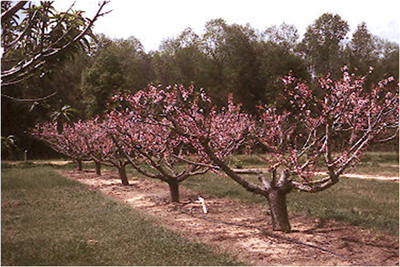
Pruning during the dormant season maintains the height and shape of the tree in addition to managing crop load (amount of potential fruit). Dormant winter pruning also affords an opportunity to alter the shape of the tree or prune out unproductive or dead wood. Summer pruning must be incorporated into a management plan during training and should be maintained for the life of the tree in order to optimize the light environment into the middle of the tree. Suboptimal lighting conditions can lead to poorly colored fruit with lower fruit quality and reduction in flower bud development for subsequent years.
Major advantages of the open vase system:
- Lower establishment costs (fewer trees per acre than other systems)
- No additional infrastructure input (e. g., trellis)
- Low height makes orchard tasks possible without using ladders
Disadvantages of the open vase system:
- Low early yields
- Late frosts may impact trees more severely because of shorter tree height
- Pruning tasks may be more difficult
Perpendicular "V" or Y-shaped Systems
Perpendicular "V" systems (DeJong et al., 1994), unlike an open vase system, can be planted at higher densities of approximately 370 trees/acre. A major advantage of this system is its uniformity in growth throughout the orchard, which can simplify pruning, fruit thinning and harvesting tasks. By simplifying the structure of the tree, canopy light distribution can be improved while increasing labor efficiency.
Planting distances for the perpendicular "V" system range from 5 - 6.5 feet between trees and 14.5 - 18 feet between rows. Wider spacing is recommended for more vigorous varieties; while closer spacing is recommended for less vigorous varieties.
As with open vase systems, young trees can be planted and then immediately pruned back to approximately 1.5 feet to encourage branching. Trees that are well-feathered do not need to be headed back as long as the branching will allow for choosing the future scaffolds.
Perpendicular "V" systems are trained to two major scaffolds, opposite of each other and perpendicular to the tree row. Fruiting wood is renewed annually from these two major scaffolds. The center of the tree is open and free of watersprouts (upright shoot growth from the main scaffold or limb of the tree); thus, it must be pruned to optimize the light environment so fruit bud initiation and development takes place.
Major advantages of the perpendicular "V" system are:
- Easy tree and orchard access
- Good canopy light distribution
- Early high orchard yields
Disadvantages of the perpendicular "V" system are:
- Higher establishment costs (more trees planted per acre)
- Higher training costs in the establishment of an orchard
Trellis-based Systems
In addition to free-standing training systems for stone fruit, several trellis-based systems have been developed around the world. The Tatura Trellis produces a "V"-shaped tree that produces early yields, minimizes pruning and can be planted at very high density. It was developed in the late 1970s in New Zealand (Chalmers et al., 1978) and trellises are required to support the growth of the tree and heavy cropload of this training system.
A major advantage of trellis-based systems is that they are well-suited to mechanization of most orchard practices. Many activities can take place using an orchard platform that can be self-propelled or self-directed. Bloom and crop load thinning activities using mechanization have also been investigated with the goal of increasing labor efficiency. Using string-thinners that attach to the front of a tractor (a. k. a. "The Darwin"), a group of researchers at Penn State (J. Schupp and colleagues) is conducting studies on fruit thinning as part of a USDA-funded multi-disciplinary project. However, despite these advantages, the cost of the infrastructure and a higher number of trees is a major disadvantage, and free-standing training systems are becoming more popular.
References
Chalmers, D., Ende, B.v.d., and Heek, L.v. 1978. Productivity and mechanization of the Tatura Trellis Orchard. HortScience 13:517-521.
Cole, S.W., 1849. The American Fruit Book. John P. Jewett, New York.
DeJong, T.M., Day, K.R., Doyle, J.F., and Johnson, R.S. 1994. The Kearney Agricultural Center Perpendicular "V" (KAC-V) Orchard System for Peaches and Nectarines. HortTechnology 4:362-367.
Taylor, K. 2003. Optimizing peach yields through training systems.
